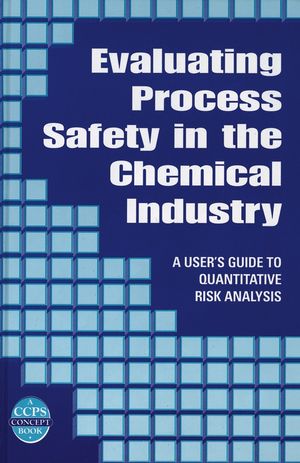Evaluating Process Safety in the Chemical Industry: A User's Guide to Quantitative Risk AnalysisISBN: 978-0-8169-0746-5
Hardcover
104 pages
June 2000
 This is a Print-on-Demand title. It will be printed specifically to fill your order. Please allow an additional 10-15 days delivery time. The book is not returnable.
|
||||||
List of Tables.
Preface.
Acknowledgments.
Executive Summary.
Advice for the Reader.
Acronyms.
Glossary.
Chapter 1. Introduction.
1.1. Background.
1.2. The Process of Risk Analysis.
1.3. Definition of QRA.
1.4. Misconceptions About QRA.
Chapter 2. Deciding Whether to Use QRA.
2.1. Some Reasons for Considering QRA.
2.2. Types of Information Available From Risk Studies.
2.3. Criteria for Electing to Use QRA.
Chapter 3. Management Use of QRA.
3.1. Chartering the Analysis.
3.1.1. Study Objective.
3.1.2. Scope.
3.1.3. Technical Approach.
3.1.4. Resources.
3.2. Selecting QRA Techniques.
3.2.1. Hazard Identification.
3.2.2. Consequence Analysis.
3.2.3. Frequency Analysis.
3.2.4. Risk Evaluation and Presentation.
3.3. Understanding the Assumptions and Limitations.
3.3.1. Completeness.
3.3.2. Model Validity.
3.3.3. Accuracy/Uncertainty.
3.3.4. Reproducibility.
3.3.5. Inscrutability.
Chapter 4. Using QRA Results.
4.1. Comparative Methods for Establishing Perspective.
4.2. Factors Influencing Risk Perception.
4.2.1. Type of Hazard.
4.2.2. Voluntary versus Involuntary.
4.2.3. Societal versus Individual.
4.2.4. Public versus Employee.
4.2.5. High Consequence/Low Frequency versus Low Consequence/High Frequency
4.2.6. Acute versus Latent Effects.
4.2.7. Familiarity.
4.2.8. Controllability.
4.2.9. Age of Exposed Population.
4.2.10. Distribution of Risk and Benefit.
4.3. Communicating Risk.
4.3.1. Accept and Involve the Public as a Legitimate Partner.
4.3.2. Plan Carefully and Evaluate Your Efforts.
4.3.3. Listen to People's Specific Concerns.
4.3.4. Be Honest, Frank, and Open.
4.3.5. Coordinate and Collaborate with Other Credible Sources.
4.3.6. Meet the Needs of the Media.
4.3.7. Speak Clearly and with Compassion.
4.4. Pitfalls in Using QRA Results.
Chapter 5. Conclusions.
References.
Suggested Additional Reading.



